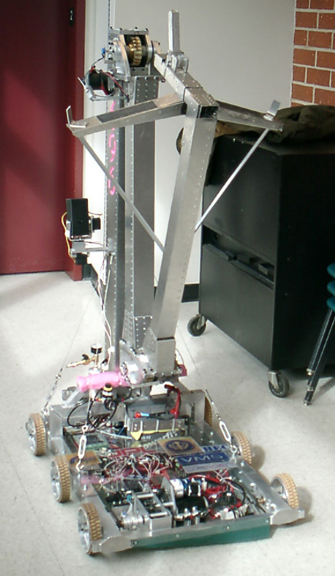GLAGH (Armstrong) — 2005

GLAGH (Armstrong) pictured at Clark
GLAGH, also known as Armstrong, was the robot we created for the game Triple Play. In this game, we had to lift PVC tetrahedrons and lift them onto bigger tetrahedrons to score. Our robot had a two-segment, double-jointed arm for manipulating game pieces, and a powerful drive train with custom designed two-speed shifting transmissions. GLAGH performed well at the Los Angeles Regional. At the end of the Friday qualification rounds, Team 696 was ranked 1st. However, due to losses in the Saturday qualification rounds, GLAGH ended up seeding 14th out of the 52 teams attending. GLAGH was picked to be a part of an alliance for elimination rounds, and made it to quarterfinals.

GLAGH modeled in Inventor
Technical Specifications:
Weight: 120.1 lbs
Height: 60 inches
Drive Train
– Powerful six-motor drive train: four CIM motors and two Fisher Price motors
– Custom built pneumatically shifted two-speed transmissions
– 15 ft/sec in high gear and 5.5 ft/sec in low gear
– Six wheel tank drive, center wheels lowered for better maneuverability
Arm
– Two-segment arm for picking up game pieces
– Independently movable shoulder and elbow joints
– Non-backdriveable joints with worm gear reductions
– Can fully extend arm with a 12 lb. tetra (game piece)
– Can "cap" and "contain in" low and high goals
– Can lift tetra to a height of 11 ft.
"End Effector"
– Static "end effector" with "hook" for simple game piece manipulation
– Works best when tetra is loaded by human
Electrical/Programming
– Shaft encoders for precise autonomous control
– Potentiometers and gyros to track arm movement autonomously
– Arm has preprogrammed scoring positions
– On-board vision camera for autonomously locating targets
